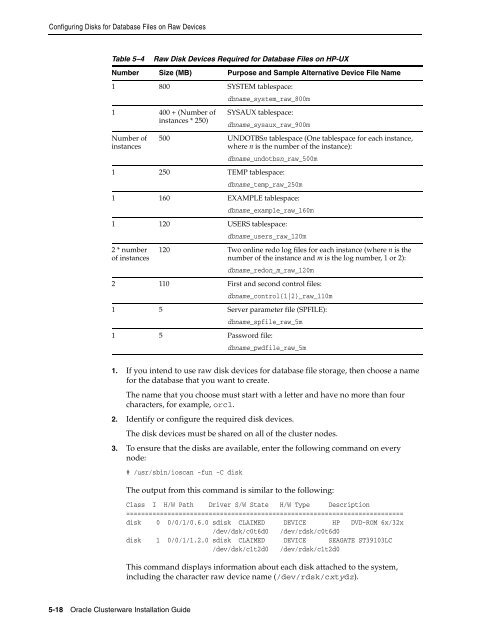Oracle Database Oracle Clusterware Installation Guide for HP-UX
Oracle Database Oracle Clusterware Installation Guide for HP-UX
Oracle Database Oracle Clusterware Installation Guide for HP-UX
You also want an ePaper? Increase the reach of your titles
YUMPU automatically turns print PDFs into web optimized ePapers that Google loves.
Configuring Disks <strong>for</strong> <strong>Database</strong> Files on Raw Devices<br />
Table 5–4 Raw Disk Devices Required <strong>for</strong> <strong>Database</strong> Files on <strong>HP</strong>-<strong>UX</strong><br />
Number Size (MB) Purpose and Sample Alternative Device File Name<br />
1 800 SYSTEM tablespace:<br />
dbname_system_raw_800m<br />
1 400 + (Number of<br />
instances * 250)<br />
Number of<br />
instances<br />
1. If you intend to use raw disk devices <strong>for</strong> database file storage, then choose a name<br />
<strong>for</strong> the database that you want to create.<br />
The name that you choose must start with a letter and have no more than four<br />
characters, <strong>for</strong> example, orcl.<br />
2. Identify or configure the required disk devices.<br />
The disk devices must be shared on all of the cluster nodes.<br />
3. To ensure that the disks are available, enter the following command on every<br />
node:<br />
# /usr/sbin/ioscan -fun -C disk<br />
5-18 <strong>Oracle</strong> <strong>Clusterware</strong> <strong>Installation</strong> <strong>Guide</strong><br />
SYSA<strong>UX</strong> tablespace:<br />
dbname_sysaux_raw_900m<br />
500 UNDOTBSn tablespace (One tablespace <strong>for</strong> each instance,<br />
where n is the number of the instance):<br />
dbname_undotbsn_raw_500m<br />
1 250 TEMP tablespace:<br />
dbname_temp_raw_250m<br />
1 160 EXAMPLE tablespace:<br />
dbname_example_raw_160m<br />
1 120 USERS tablespace:<br />
2 * number<br />
of instances<br />
dbname_users_raw_120m<br />
120 Two online redo log files <strong>for</strong> each instance (where n is the<br />
number of the instance and m is the log number, 1 or 2):<br />
dbname_redon_m_raw_120m<br />
2 110 First and second control files:<br />
dbname_control{1|2}_raw_110m<br />
1 5 Server parameter file (SPFILE):<br />
dbname_spfile_raw_5m<br />
1 5 Password file:<br />
dbname_pwdfile_raw_5m<br />
The output from this command is similar to the following:<br />
Class I H/W Path Driver S/W State H/W Type Description<br />
==========================================================================<br />
disk 0 0/0/1/0.6.0 sdisk CLAIMED DEVICE <strong>HP</strong> DVD-ROM 6x/32x<br />
/dev/dsk/c0t6d0 /dev/rdsk/c0t6d0<br />
disk 1 0/0/1/1.2.0 sdisk CLAIMED DEVICE SEAGATE ST39103LC<br />
/dev/dsk/c1t2d0 /dev/rdsk/c1t2d0<br />
This command displays in<strong>for</strong>mation about each disk attached to the system,<br />
including the character raw device name (/dev/rdsk/cxtydz).
















